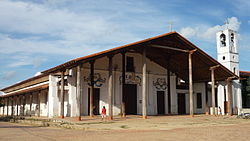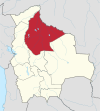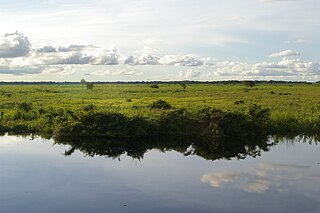
Beni, sometimes El Beni, is a northeastern department of Bolivia, in the lowlands region of the country. It is the second-largest department in the country, covering 213,564 square kilometers, and it was created by supreme decree on November 18, 1842, during the administration of General José Ballivián. Its capital is Trinidad.

Rurrenabaque is a small town in the north of Bolivia on the Beni River. It is the capital of Rurrenabaque Municipality. In recent years it has become popular with international tourism as it is an easy gateway for visits to Madidi National Park, as well as the surrounding pampas. Locals commonly refer to the town by its shortened nickname, "Rurre."

Trinidad, Kimsantin officially La Santísima Trinidad, is a city in Bolivia, capital of the department of Beni. The population is 130,000. While historically a peripheral city in Bolivia, Trinidad is today an important center for the Bolivian Bovine industry and has enjoyed a modest economic boom in recent years and enjoys an HDI index of above 0.700.
Moxos is a province in the Beni Department, Bolivia. It is named after the Moxos savanna.

Riberalta is a town in the Beni Department in northern Bolivia, situated where the Madre de Dios River joins the Beni River. Riberalta is on the south bank of the Beni River.
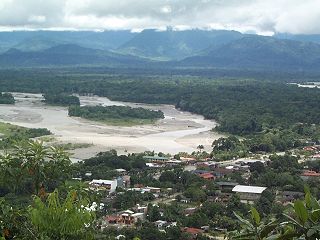
Villa Tunari or Tunari is a location in the department of Cochabamba, Bolivia. It is the seat of the Villa Tunari Municipality, the third municipal section of the Chapare Province. According to the census 2012 the population was 3,213 in the town which is an increment from 2,510 registered during the 2001 census.

The Beni savanna, also known as the Llanos de Moxos or Moxos plains, is a tropical savanna ecoregion of the Beni Department of northern Bolivia.

The Mojeños, also known as Moxeños, Moxos, or Mojos, are an indigenous people of Bolivia. They lived in south central Beni Department, on both banks of the Mamore River, and on the marshy plains to its west, known as the Llanos de Mojos. The Mamore is a tributary to the Madeira River in northern Bolivia.
Loreto is a smalI municipality in the Beni Department in northern Bolivia, capital of the Marbán Province and Loreto Municipality. In 2001, Loreto had a population of 843.
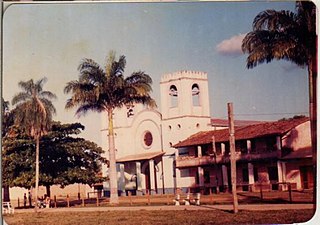
Magdalena is a town on the Itonomas River in the Beni Department in northern Bolivia, capital of the Iténez Province and the Magdalena Municipality.
Chimoré is a location in the Carrasco Province, Cochabamba Department, Bolivia. It is the seat of the Chimoré Municipality.
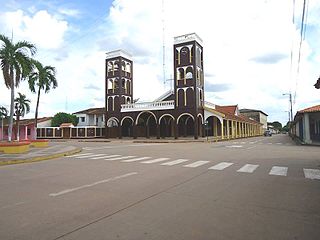
Santa Ana del Yacuma is a town in the Beni Department in north-eastern Bolivia.
Moxo is any of the Arawakan languages spoken by the Moxo people of the Llanos de Moxos in northeastern Bolivia. The two extant languages of the Moxo people, Trinitario and Ignaciano, are as distinct from one another as they are from neighboring Arawakan languages. The extinct Magiana was also distinct.

San Joaquín is a small agricultural town in the Beni Department in the Bolivian lowlands.

Yapacaní is the largest city in the province of Ichilo in the Bolivian department of Santa Cruz. It lies on the west bank of the Yapacani River, at the mouth of the Surutú River, 100 km north-west of Santa Cruz de la Sierra, the largest city in Bolivia. It is the centre of the district of Yapacaní Municipio. Prior to its foundation on 23 August 1953, there was a military post called El Comando.
San Javier (Beni) is a small town in Bolivia.
San Ignacio de Moxos Airport is a public use airport serving the town of San Ignacio de Moxos in the Beni Department of Bolivia. The runway is 3 kilometres (1.9 mi) north of the town.

The Llanos de Moxos, also known as the Llanos de Mojos and the Beni Savanna, have extensive remains of pre-Columbian agricultural societies scattered over most of Beni Department, Bolivia. The remains testify to a well-organized and numerous indigenous people. This contradicts the traditional view of archaeologists, notably Betty Meggers, who asserted that the Amazon River Basin was not environmentally able to sustain a large population and that its indigenous inhabitants were hunter-gatherer bands or slash-and-burn farmers. In the 1960s, petroleum company geologists and geographer William Denevan were among the first to publicize the existence of extensive prehistoric earthworks constructed in the Amazon, especially in the Llanos de Moxos.

The Jesuit Missions of Moxos are located in the Llanos de Moxos of Beni department in eastern Bolivia. Distinguished by a unique fusion of European and Amerindian cultural influences, the missions were founded as reductions or reducciones de indios by Jesuits in the 17th and 18th centuries to convert local tribes to Christianity.
